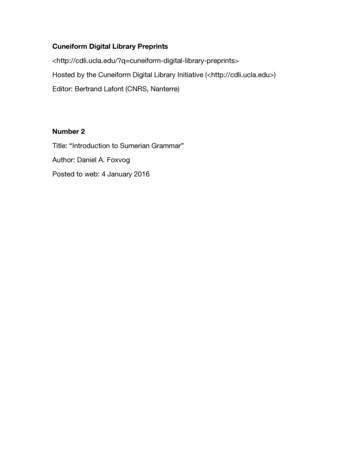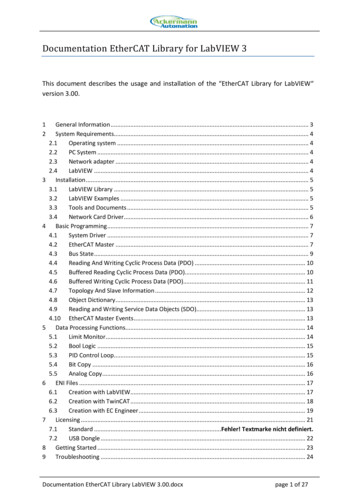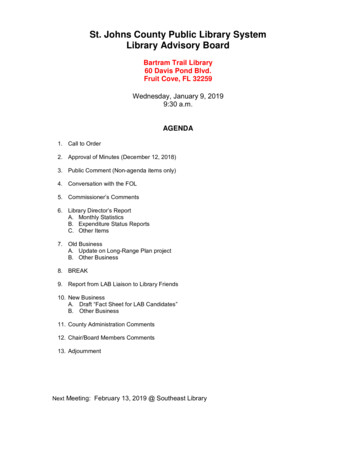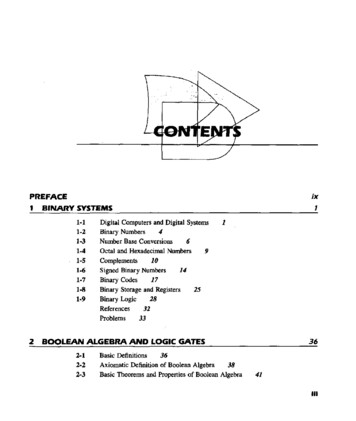
Transcription
Cuneiform Digital Library Preprints http://cdli.ucla.edu/?q cuneiform-digital-library-preprints Hosted by the Cuneiform Digital Library Initiative ( http://cdli.ucla.edu )Editor: Bertrand Lafont (CNRS, Nanterre)Number 2Title: “Introduction to Sumerian Grammar”Author: Daniel A. FoxvogPosted to web: 4 January 2016
INTRODUCTION TO SUMERIAN GRAMMARDANIEL A FOXVOGLECTURER IN ASSYRIOLOGY (RETIRED)UNIVERSITY OF CALIFORNIA AT BERKELEYRevised January 2016
CONTENTSPREFACE4THE SUMERIAN WRITING SYSTEM5PHONOLOGY17NOUNS AND ADJECTIVES22THE NOMINAL CHAIN27PRONOUNS AND DEMONSTRATIVES30SUMMARY OF PERSONAL PRONOUN FORMS37THE ADNOMINAL CASES: GENITIVE AND EQUATIVE38THE COPULA44ADVERBS AND NUMERALS49THE ADVERBAL CASES53INTRODUCTION TO THE VERB60DIMENSIONAL PREFIXES 1: INTRODUCTION68DIMENSIONAL PREFIXES 2: DATIVE73DIMENSIONAL PREFIXES 3: COMITATIVE, ABLATIVE-INSTRUMENTAL, TERMINATIVE78CORE PREFIXES: ERGATIVE, LOCATIVE-TERMINATIVE, LOCATIVE84THE VENTIVE ELEMENT91RELATIVE CLAUSES: THE NOMINALIZING SUFFIX -a97PREFORMATIVES (MODAL PREFIXES)104THE IMPERATIVE111IMPERFECTIVE FINITE VERBS119PARTICIPLES AND THE INFINITIVE130APPENDIX 1: CHART OF VERBAL PREFIX CHAIN ELEMENTSTABLE OF SYLLABIC SIGN VALUES155156APPENDIX 2: THE EMESAL DIALECT158INDEX159EXERCISES1613
PREFACEEntia non sunt multiplicandapraeter necessitatemWilliam of OckhamThis grammar is intended primarily for use in the first year of university study under the guidance of a teacher who candescribe the classic problems in greater detail, add current alternative explanations for phenomena, help the studentparse and understand the many textual illustrations found throughout, and provide supplementary information aboutthe history of the language and the culture of early Mesopotamia. A few exercises have been provided to accompanystudy of the lessons, some artificial, others drawn from actual texts. Both require vocabulary lookup from the companion Elementary Sumerian Glossary or a modern substitute such as the online Pennsylvania Sumerian Dictionary.Upon completing this introduction, the student will be well prepared to progress to sign learning and reading of texts.Konrad Volk's A Sumerian Reader (Studia Pohl Series Maior 18, Rome, 1997-) is a good beginning.This introduction may also be of benefit to those who have already learned some Sumerian more or less inductivelythrough the reading of simple royal inscriptions and who would now like a more structured review of its grammar,with the help of abundant textual illustrations, from something a bit more practical and pedagogically oriented than theavailable reference grammars.Cross-references have often been provided throughout to sections (§) in Marie-Louise Thomsen's earlier standard TheSumerian Langauge (Copenhagen, 19872), where additional information and further examples can often be found forindividual topics. A newer restatement of the grammatical system is Dietz Otto Edzard's Sumerian Grammar (Leiden,2003). An up to date quick overview is Gonzalo Rubio's "Sumerian Morphology," in Alan S. Kaye (ed.), Morphologies of Asia and Africa II (2007) 1327-1379. Pascal Attinger's encyclopedic Eléments de linguistique sumérienne(Fribourg, 1993) is a tremendously helpful reference but beyond the reach of the beginner. Abraham H. Jagersma'srevolutionary new and monumental Descriptive Grammar of Sumerian (2010) is now available for download on theWeb and will eventually be published by Oxford University Press.For standard Assyriological abbreviations used in this introduction see the Abbreviations for Assyriology of theCuneiform Digital Library Initiative (CDLI) on the Web. The standard academic online dictionary is the ElectronicPennsylvania Sumerian Dictionary (ePSD). The chronological abbeviations used here are:OSOAkkUr IIIOBOld Sumerian periodOld Akkadian (Sargonic) period3rd Ur Dynasty (Neo-Sumerian) periodOld Babylonian period(2500-2350 BC)(2350-2150 BC)(2150-2000 BC)(1900-1600 BC)For those who may own a version of my less polished UC Berkeley teaching grammar from 1990 or earlier, the presentversion will be seen to be finally comprehensive, greatly expanded, hopefully much improved, and perhaps worth aserious second look. My description of the morphology and historical morphophonemics of the verbal prefix systemremains an idiosyncratic, somewhat unconventional minority position. Jagersma's new description, based in manyrespects upon a new system of orthographic and morphophonological rules, is now popular especially in Europe, andit may well eventually become the accepted description among many current students of Sumerian grammar.This will be the last updated, final, edition of this grammar.Guerneville, California USAJanuary 20164
THE SUMERIAN WRITING SYSTEMI. TRANSLITERATION CONVENTIONSA. Sign Diacritics and Index NumbersSumerian features a large number of homonyms – words that were pronounced similarly but had differentmeanings and were written with different signs, for example:/du/ 'to come, go'/du/ 'to build'/du/ 'to release'A system of numerical subscripts, and diacritics over vowels representing subscripts, serves to identifyprecisely which sign appears in the actual text. The standard reference for sign identification remains R.Labat's Manuel d'Epigraphie akkadienne (1948-), which has seen numerous editions and reprintings. Y.Rosengarten's Répertoire commenté des signes présargoniques sumériens de Lagaš (1967) is indispensiblefor reading Old Sumerian texts. R. Borger's Assyrisch-babylonische Zeichenliste (AOAT 33/33a, 1978-) isnow the modern reference for sign readings and index numbers, although the best new signlist for OBSumerian literary texts is the Altbabylonische Zeichenliste der sumerisch-literarischen Texte by C. Mittermayer & P. Attinger (Fribourg, 2006). Borger's AbZ index system which is used here is as follows:Single-syllable signsMultiple-syllable signsdu( du1)murudú( du2)múrudù( du3)mùrudu4etc.muru4Note that the diacriticalways falls on the FIRSTVOWEL of the word!There is variation in the systems employed in older signlists for multiple- syllable signs, especially in Labat.In the earliest editions of his signlist which may still be encountered in libraries, Labat carried the use ofdiacritics through index numbers 4-5 by shifting the acute and grave accents onto the first syllable of multiplesyllable signs:murú( muru2)murù( muru3)múru( muru4)mùru( muru5)5
This would not be a problem except for a number of signs which have long and short values. For example, thesign túk can be read /tuk/ or /tuku/. Labat reads the latter as túku, which then does not represent tuku4, butrather tuku2, i.e. túk(u)! Borger's system, used here and in later editions of Labat, is more consistent, placingthe diacritics on the first syllable of multi-syllable signs, but using them only for index numbers 2 and 3.New values of signs, pronunciations for which no generally accepted index numbers yet exist, are given an "x"subscript, e.g. dax 'side'.Note, finally, that more and more frequently the acute and grave accents are being totally abandoned in favorof numeric subscripts throughout. This, for example, is the current convention of the new PennsylvaniaSumerian Dictionary, e.g. du, du2, du3, du4, etc. Since the system of accents is still current in Sumerologicalliterature, however, it is vital that the beginner become familiar with it, and so it has been maintained here.B. Upper and Lower Case, Italics, and BracketsIn unilingual Sumerian contexts, Sumerian words are normally written in lower case roman letters. Upper case(capital) letters (CAPS) are used:1) When the exact meaning of a sign is unknown or unclear. Many signs are polyvalent, that is, theyhave more than one value or reading. When the particular reading of a sign is in doubt, one mayindicate this doubt by choosing its most common value and writing this in CAPS. For example, in thesentence KA-ĝu10 ma-gig 'My KA hurts me' a body part is intended. But the KA sign can be read ka'mouth', kìri 'nose' or zú 'tooth', and the exact part of the face might not be clear from the context. Bywriting KA one clearly identifies the sign to the reader without committing oneself to any of itsspecific readings.2) When the exact pronunciation of a sign is unknown or unclear. For example, in the phrase a-SIS'brackish water', the pronunciation of the second sign is still not completely clear: ses, or sis? Ratherthan commit oneself to a possibly incorrect choice, CAPS can be used to tell the reader that the choiceis being left open.3) When one wishes to identify a non-standard or "x"-value of a sign. In this case, the x-value isimmediately followed by a known standard value of the sign in CAPS placed within parentheses, forexample dax(Á) ‘side’.4) When one wishes to spell out the components of a compound logogram, for exampleénsi(PA.TE.SI) 'governor' or ugnim(KI.KUŠ.LU.ÚB.ĜAR) 'army'.5) When referring to a sign in the abstract, as in “the ŠU sign is the picture of a hand.”In bilingual or Akkadian contexts, a variety of conventions exist. Very commonly Akkadian words are writtenin lower case roman or italic letters with Sumerian logograms in CAPS: a-na É.GAL-šu 'to his palace'. Insome publications one also sees Sumerian words written in s p a c e d r o m a n letters, with Akkadian in eitherlower case roman letters or italics. In other newer publications Sumerian is even printed in boldface type.Determinatives, unpronounced indicators of meaning, are written with superscripts in Sumerological literature,or, often, in CAPS on the line in Akkadian contexts: gišhašhur or ĜIŠ.HAŠHUR. They are also sometimesseen written lower case on the line separated by periods: ĝiš.hašhur.Partly or wholly missing or broken signs can be indicated using square brackets, e.g. lu[gal] or [lugal] ‘king’.Partly broken signs can also be indicated using half-brackets. A sign presumed to have been omitted by theancient scribe is indicated by the use of angle brackets, while an erroneously repeated sign deleted by amodern editor is indicated by the use of double angle angle brackets.6
C. Conventions for Linking Signs and WordsHyphens and PeriodsIn Akkadian contexts, hyphens are always used to transliterate Akkadian, while periods separate theelements of Sumerian words or logograms. In Sumerian contexts, periods link the parts of compoundsigns written in CAPS, and hyphens are used elsewhere, e.g.:énsi(PA.TE.SI) 'governor'kušgur21(É.ÍB)ùr 'shield'an-šè 'towards heaven'Problems can arise, however, when one attempts to formulate rules for the linking of the elements inthe chain formations characteristic of Sumerian. The formal definition of a Sumerian word remainsproblematic (see J. Black, "Sumerian Lexical Categories," Zeitschrift für Assyriologie 92 [2002] 60ff.and G. Cunningham, "Sumerian Word Classes Reconsidered," in Your Praise is Sweet. A MemorialVolume for Jeremy Black [London, 2010] 41-52.) Consequently, we only transliterate Sumerian signby sign; we do not usually transcribe "words." Verbal chains consist of stems and affixes alwayslinked together into one unit. But nominal chains (phrases) often consist of adjectives, appositions,dependent genitive constructions, and relative clauses beside head nouns and suffixes, and the linkingor separation of various parts of nominal chains in unilingual Sumerian contexts is subject to the training and habits of individual scholars. One rule of thumb is: the longer the the chain, the less likely itsparts will be linked with hyphens. The main criterion at work is usually clarity of presentation.Components of standard nominal compounds and proper nouns are normally linked:dub-sar ‘tablet writer’ ‘scribe’an-ki ‘heaven and earth’en-mete-na ‘(the king) Enmetena’Adjectives were always in the past joined to the words they modify, but most scholars nowwrite an adjective as a separate word:dumu-tur or dumu tur 'child small' ‘the small child’Verbal adjectives (past participles) are now also less often linked:é-dù-a or é dù-a ‘house that was built’ ‘the built house’The two parts of a genitive construction are today never linked unless they are components ofa compound noun:é lugal-la ‘the house of the king’zà-mu‘edge of the year’ ‘New Year’ {é lugal ak}{zà mu ak}In the absence of a universally accepted methodology, one must attempt to develop one's own sensitivity to how Sumerian forms units of meaning. Our conventions for linking signs and words areintended only to help clarify the relationships between them and to aid in the visual presentation of thelanguage. The writing system itself makes no such linkages and does not employ any sort of punctuation. One should take as models the usual practices of established scholars. One should also try to beconsistent.7
Plus ( ) and Times (x) in Sign DescriptionsWhen one sign is written inside (or, especially in older texts, above or below) another sign, theresulting new sign may be described by writing both components in CAPS, with the base sign andadded sign separated by an "x":KAxAMOUTH times WATER naĝ 'to drink'If the reading/pronunciation of such a sign also happens to be unknown, this, by necessity, willactually be the standard way to transliterate it until a new reading is proposed:IRIxACITY times WATER 'the city IRIxA'Two signs joined closely together, especially when they share one or more wedges in common or havelost some feature as a result of the close placement, are called ligatures. Signs featuring an archaicreversal of the order of their components can also be called ligatures. The parts of ligatures are traditionally linked with a "plus" character, although some scholars will also use a period:GAL LÚBIG plus MAN lugal 'king'GAL UŠUMSÌG UZUBIG plus SERPENT ušumgal 'dragon'HIT plus FLESH túd 'to beat, whip'ZU AB abzu '(mythical) subterranean ocean, abyss'EN ZU suen 'Suen (the moon god)'More complicated compound signs may feature a number of linked elements, with parenthesesmarking subunits, e.g.:DAG KISIM5x(UDU.MÁŠ) amaš 'sheepfold'ColonEspecially in publications of archaic or Old Sumerian texts in which the order of signs is not as fixedas in later periods, a colon may be used to tell the reader that the order of the signs on either side of thecolon is reversed in actual writing, e.g. za:gìn for written GÌN-ZA instead of normal za-gìn 'lapislazuli'. Multiple colons can also be used to indicate that the proper order of signs is unknown. Thus a8
transliteration ba:bi:bu would signify: "I have no idea which sign comes first, second or third!"II. ORIGIN AND DEVELOPMENT OF THE SIGN SYSTEMD. Schmandt-Besserat has demonstrated that cuneiform writing per se developed rather abruptly towards theend of the 4th millennium from a system of counting tokens that had long been in use throughout the AncientNear East. Our oldest true texts, however, are the pictographic tablets that come from level IVa at Uruk (ca.3100 BC). Other archaic texts come from later Uruk levels, from Jemdet Nasr, and from Ur (1st Dynasty, ca.2700 BC). Many of these old documents are still difficult to read, but much new progress has recently beenmade. By ca. 2600 BC the texts become almost completely intelligible and feature a developing mixed logographic and syllabic cuneiform writing system.The term "pictogram (pictographic)" is used exclusively to refer to the signsof the archaic texts, in which "pictures" were drawn on clay with a pointed stylus.The terms "ideogram (ideographic)" and "logogram (logographic)" are more or lessinterchangeable and refer to signs which represent "ideas" or "words" respectively,as opposed to signs which represent syllabic values or mere sounds. Logogram isthe term used by modern Sumerologists.Signs depicting concrete objects form the ultimate basis of the archaic system. They may represent wholeobjects:kur 'mountain'šu'hand'še'(ear of) grain'or significant parts of objects:gudr 'bull, ox'áb'cow'Other signs were a bit more abstract, but are still comprehensible:a'water'ĝi6 'night'Many other archaic signs, however, are either too abstract or, oddly enough, too specific and detailed, for us toidentify as yet. The large number of often minutely differentiated signs characteristic of the archaic textssuggests that an attempt was made to produce one-to-one correspondences between signs and objects. Thissystem no doubt soon became unwieldy, and, moreover, could not easily express more abstract ideas orprocesses. Therefore, alternative ways of generating signs were developed.9
gunû and šeššig SignsOne method of generating new signs was to mark a portion of a base sign to specify the object intended. Themarks are called by the Akkadian scribes either gunû-strokes (from Sumerian gùn-a 'colored, decorated') oršeššig-hatchings (due to the resemblance of the strokes to the early cross-hatched form of the Sumerian signfor grain, še). Compare the following two sets of signs:SAĜKADAÁIn the first set, the base sign is saĝ 'head'. Strokes over the mouth portion produces SAĜ-gunû, to be read ka'mouth'. In the second set, the base sign is da 'side' (i.e., a shoulder, arm and hand). Hatchings over the armportion produces DA-šeššig, to be read á 'arm'.Compound SignsNew signs were generated by combining two or more signs:1) Doubling or even tripling the same sign:DUDUANANAN su8(b)'to come, go (plural)', the imperfective plural stemof the the verb du 'to come, go' mul'star', using a sign which originally depicted a star,but later came to be read either an 'sky' or diĝir 'god'2) Combining two (or more) different signs to produce a new idea by association of ideas:KAxAmouth water naĝ'to drink'KAxNINDAmouth bread gu7'to eat'A ANwater sky šèĝ'to rain'NÍĜINxAencircled area water ambar 'marsh'10
NÍĜINxBÙRencircled area hole pú'well'MUNUS URfemale dog nig 'bitch'3) Adding to a base sign a phonetic indicator which points to the pronunciation of a word associated inmeaning with the base sign: KAxMEmouth me eme 'tongue'KAxNUNmouth nun nundum 'lip'EZENxBADwalled area bad bàd 'city wall'UD.ZÚ.BARsun zubar zubar/zabar 'bronze'PolyvalencyThe most important new development by far was the principle of polyvalency, the association of semanticallyrelated "many values" with a particular sign, each with its own separate pronunciation. This became a veryproductive and simple method of generating new logographic values. For example:apin 'plow'can also be readuru4engaràbsin'to plow''plowman, farmer''furrow'ka'mouth' can also be readkìri 'nose'zú'tooth'inim 'word'pa'branch' can also be readĝidri 'scepter'sìg'to hit'ugula 'foreman'utu 'sun'can also be readud'light, day, time'babbar 'shining, white'àh'dried, withered'an 'sky'can also be readdiĝir 'god, goddess, deity'11
DeterminativesTo help the reader decide which sign or possible value of a polyvalent sign was intended by the writer, the useof determinatives arose. A determinative is one of a limited number of signs which, when placed before orafter a sign or group of signs, indicates that the determined object belongs to a particular semantic category,e.g. wooden, reed, copper or bronze objects, or persons, deities, places, etc. Determinatives were still basicallyoptional as late as the Ur III period (2114-2004). When Sumerian died as a spoken language, they becameobligatory. Determinatives were presumably not to be pronounced when a text was read, and to show that theyare not actually part of a word we transliterate them, in unilingual Sumerian context at least, as superscripts.To use the example of the 'plow' sign above, the polyvalent sign APIN is readapin - if preceded by a 'wood' determinative: gišapin 'plow'engar - if preceded by a 'person' determinative: lúengar 'plowman', buturu4 'to plow' or àbsin 'furrow' elsewhere, depending upon context.Rebus Writing and Syllabic ValuesAt some point rebus writings arose, where the sign for an object which could easily be drawn was used towrite a homophonous word which could not so easily be depicted, especially an abstract idea. For example,the picture of an arrow, pronounced /ti/, became also the standard sign for ti 'rib' as well as for the verb ti(l) 'tolive'. The adoption of the rebus principle was a great innovation, but it adds to the difficulty of learning theSumerian writing system, since meanings of words thus written are divorced entirely from the original basicshapes and meanings of their signs.With the expansion of the rebus principle the development of syllabic, or purely phonological, values of signsbecame possible. For example, the logograms mu 'name' or ga 'milk' could now be used to write the verbalprefixes mu- 'hither, forth' or ga- 'let me', that is, grammatical elements which were not really logograms, but,rather, indicated syntactic relationships within the sentence. A regular system of syllabic values also madepossible the spelling out of any word – especially useful when dealing with foreign loanwords, for which noproper Sumerian logograms existed.Finally, a limited set of some ninety or so Vowel, Consonant-Vowel, and Vowel-Consonant syllabic valuesformed the basis of the Akkadian writing system, modified somewhat from the Sumerian to render differentsounds in the Akkadian phonemic inventory and then expanded over time to produce many new phonetic andeven multiple-syllable values (CVC, VCV, CVCV).The Sumero-Akkadian writing system was still in limited use as late as the 1st century A.D.; the last knowntexts are astronomical in nature and can be dated to ca. 76 A.D. The system thus served the needs of Mesopotamian civilizations for a continuous span of over 3200 years – a remarkable achievement in human history.III. ORTHOGRAPHYThe fully developed writing system employs logograms (word signs), syllabic signs (sound values derivedfrom word signs), and determinatives (unpronounced logograms which help the reader choose from among thedifferent logographic values of polyvalent signs) to reproduce the spoken language. Some now speak ofthe received system as logophonetic or logosyllabic in character.12
LogogramsMany Sumerian logograms are written with a single sign, for example a 'water'. Other logograms are writtenwith two or more signs representing ideas added together to render a new idea, resulting in a compound sign orsign complex which has a pronunciation different from that of any of its parts, e.g.:KAxA naĝ 'to drink' (combining KA 'mouth' and A 'water')Á.KALAG usu 'strength' (combining Á 'arm' and KALAG 'strong')Such compound logograms should be differentiated from compound words made up of two or morelogograms, e.g.:kù-babbar‘silver'(lit. 'white precious metal')kù-sig17'gold'(lit. 'yellow precious metal')ur-mah'lion'(lit. 'great beast of prey')za-dím'lapidary' (lit. 'stone fashioner')Logograms are used in Sumerian to write nominal and verbal roots or words, and in Akkadian as a kind ofshorthand to write Akkadian words which would otherwise have to be spelled out using syllabic signs. Forexample, an Akkadian scribe could write the sentence 'The king came to his palace' completely syllabically:šar-ru-um a-na e-ka-al-li-šu il-li-kam. He would be just as likely, however, to use the common Sumerianlogograms for 'king' and 'palace' and write instead LUGAL a-na É.GAL-šu il-li-kam.Syllabic SignsSyllabic signs are used in Sumerian primarily to write grammatical elements. They are also commonly used towrite words for which there is no proper logogram. Sometimes this phonetic writing is a clue that the word inquestion is a foreign loanword, e.g. sa-tu Akkadian šadû 'mountain'.Texts in the Emesal dialect of Sumerian feature a high percentage of syllabic writings, since many words inthis dialect are pronounced differently from their main dialect (Emegir) counterparts and so cannot be writtenwith their usual logograms. For example, Emesal ka-na-áĝ Emegir kalam 'nation', Emesal u-mu-un Emegir en 'lord'. We also occasionally encounter main dialect texts written syllabically, but usually only fromperipheral geographical areas such as the Elamite capital of Susa (in Iran) or northern Mesopotamian sites suchas Shaduppum (modern Tell Harmal) near Baghdad.Syllabic signs are occasionally used as glosses on polyvalent signs to indicate the proper pronunciations; wenormally transliterate glosses as superscripts as we do determinatives, for example: èn ba-na-tarar 'he wasquestioned'. An early native gloss may rarely become fixed as part of the standard writing of a word. The bestexample is the word for 'ear, intelligence', which can be written three different ways, two of which incorporatefull glosses:1) The sign ĝeštug is written:PI2) The sign ĝéštug is written:geš-túgPI13
3) The sign ĝèštug is written:gešPItúgDeterminativesDeterminatives are logograms which may appear before or after words which categorize the latter in a varietyof ways. They are orthographic aids and were presumably not pronounced in actual speech. They begin to beused sporadically by the end of the archaic period. While they were probably developed to help a reader chosethe desired value of a polyvalent sign, they are often employed obligatorily even when the determined logoramis not polyvalent. For example, while the wood determinative ĝiš may be used before the PA ‘branch’ sign tohelp specify its reading ĝidri 'scepter', rather than, e.g., sìg 'to hit', ĝiš is also used before hašhur 'apple (tree orwood)' even though this sign has no other reading. Other common functions are to help the reader distinguishbetween homonymous words, e.g. ad 'sound' and gišad 'plank' or between different related readings of a word,e.g. nú 'to lie down, sleep' but gišĝèšnu(NÚ) 'bed'.The following determinatives are placed BEFORE the words they determine and so are referred to (abbr. m)lúmunus (abbr. f)diĝir (abbr. d)duggiĝiši7 (or íd)kušmulna4šimtúg (or tu9)úiriurudauzuone, (item)man, personwoman, femalegodpotreedtree, woodwatercourseskinstarstonearomatic, resingarmentgrasscitycopperfleshpersonal names (usually male)many male professionsfemale names and professions*deitiesvesselsreed varieties and objectstrees, woods, and wooden objectscanals and riversleather hides and objectsplanets, stars, and constellationsstones and stone objectsaromatic substances(woolen) garmentsgrassy plants, herbs, cerealscity names (previously read uru)copper and bronze objects (also read urudu or urud)body parts, meat cuts*An Akkadian invention, not actually attested in Sumerian texts(so P. Steinkeller, Orientalia 51 [Rome, 1982] 358f.)The following determinatives are placed AFTER the words they determine and so are referred to irdgreenszabarbronzecities and other geographic entitiesfish, amphibians, crustaceansbirds, insects, other winged animalsvegetables (the reading sar 'garden plot'is now obsolete but still often seen)bronze objects (often combined withthe pre-determinative uruda)14
Long and Short Pronunciations of Sumerian RootsMany Sumerian nominal and verbal roots which end in a consonant drop that con sonant when the root is notfollowed by some vocalic element, i.e., at the end of a word complex or nominal chain or when followed by aconsonantal suffix. For example, the simple phrase 'the good child' is written dumu-du10, and it was presumably actually pronounced /dumu du/. When the ergative case suffix -e 'by' is added, however, the same phrasewas pronounced /dumu duge/. We know this is so because the writing system "picks up" the dropped consonant of the adjective and expresses it linked with the vowel in a following syllabic sign: dumu-du10-ge.This hidden consonant is generally referred to by the German term Auslaut 'final sound', as in "the adjectivedu10 has a /g/ Auslaut."Our modern signlists assign values to such signs both with and without their Auslauts, thus giving both a"long" and "short" value for each sign, e.g.:dùg, du10'good'kudr, ku5 'to cut'dug4, du11 'to do'níĝ, nìgudr, gu4šag4, šà'bull, ox''thing''heart, interior'In older academic literature the long values were generally used everywhere; the phrase 'by the good child'would thus have been transliterated dumu-dùg-ge. But this has the disadvantage of suggesting to the readerthat an actual doubling of the consonant took place, and, in fact, many names of Sumerian rulers, deities andcities known from the early days of Assyriology are still found cited in forms containing doubled consonantswhich do not reflect their actual Sumerian pronunciations, e.g. the goddess Inanna, rather than Inana, or theking Mesannepadda, rather than Mesanepada. After World War II, Sumerologists began to bring the transliteration of Sumerian more into line with its actual pronunciation by utilizing the system of short sign valueswhich is still preferred by the majority of scholars, although there is now a tendency to return to the longvalues among some Old Sumerian specialists. Certainly it was the short values that were taught in the OldBabylonian scribal schools, to judge from the data of the Proto-Ea signlists (see J. Klein & T. Sharlach,Zeitschrift für Assyriologie 97 [2007] 4 n. 16). Eventually one must simply learn to be comfortable with boththe long and short values of every sign which features an amissible final consonant, though at first it will besufficient just to learn the short values together with their Auslauts, e.g. du10(g), ku5(dr), etc.If hidden Auslauts create extra problems in the remembering of Sumerian signs or words, the rules of orthography offer one great consolation: a final consonant picked up and expressed overtly in a following syllabicsign is a good indication as to the correct reading of a polyvalent sign. For example, KA-ga can only be readeither ka-ga 'in the mouth' or du11-ga 'done', whereas KA-ma can only be read inim-ma 'of the word'.Probably basically related to the preceding phenomenon is the non-significant doubling of consonants in otherenvironments. For example, the verbal
Jan 04, 2016 · But the KA sign can be read ka 'mouth', kìri 'nose' or zú 'tooth', and the exact part of the face might not be clear from the context. By writing KA one clearly identifies the sign to the reader without committing oneself to any of its specific readings. 2) When the exact pronun










